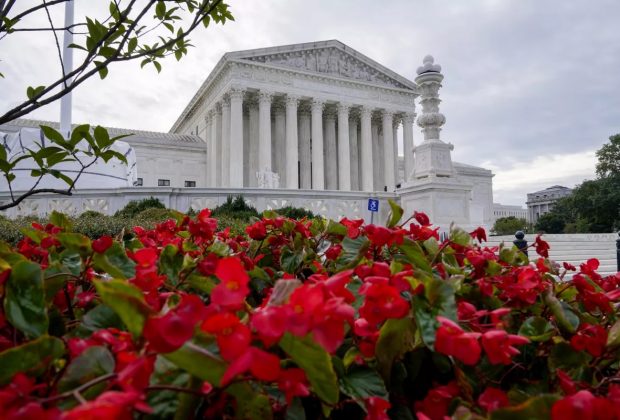The Supreme Court could decide the fate of the DACA policy within the next two years. DACA provides protection from deportation and gives legal work authorization to roughly 600,000 undocumented individuals who came to the U.S. as young children. A recent federal court decision will likely send the case to the Supreme Court; if the Justices choose to hear the case, their ruling will likely determine once and for all if those protections can remain in place.
By FWD.us Team | FWD.us | Feb. 2, 2024 | Photo By Associated Press
The Fifth Circuit Court of Appeals is reviewing the case against DACA
The case challenging the legality of the DACA policy is currently under review by the Fifth Circuit Court of Appeals. Opening briefs have been filed by the appellants (those defending DACA, including the Biden administration and leading advocacy organizations) in January, and will be answered by the opposition (those trying to end DACA) by February 26th.
In February, legal briefs were submitted by amici curiae, or “friends of the court,” detailing the devastating impacts that ending DACA would have on children and families, communities, and the economy. More than 450 individual amici, including leaders in the business community, higher education, and state governments, among many others, are represented across seven briefs.
If the court schedules oral arguments, they could happen as early as Spring 2024, and a decision could be issued in the months following.
The Supreme Court could control the futures of 600,000 DACA recipients
The Supreme Court could decide within the next year whether to hear a case about the legality of the Deferred Action for Childhood Arrivals (DACA) policy.
In September 2023, Judge Andrew Hanen, a federal judge in the U.S. Southern District of Texas, who issued a ruling declaring that the DACA program is illegal. While Judge Hanen’s most recent ruling does not impact DACA recipients’ current protections or their ability to continue to renew them, the decision is another cruel and disheartening indication that the courts plan to terminate this vital lifeline for hundreds of thousands of young immigrants and their families.
Judge Hanen’s ruling is not the final step. An appeal of his ruling has been filed, and is being heard by the Fifth Circuit Court of Appeals, which also previously ruled against DACA. Assuming the Fifth Circuit rules the same way again, the case will then likely be appealed up to the Supreme Court. The timing of the Fifth Circuit’s decision is unpredictable, however, and the timeline for the Supreme Court to respond to a request to review the case could range from anywhere late 2024 to early 2025; if such a request is granted, the case may not be heard until spring 2025.
Considering the current makeup of the Court and its previous immigration decisions, there’s a good chance the Justices could also rule against DACA. If the Court ultimately upholds Judge Hanen’s ruling, and if the Court prohibits the government from processing DACA renewals, the 600,000 current DACA recipients could be stripped of their ability to work legally, and would be exposed to the threat of deportation.
If DACA renewals are ended, an estimated 1,000 DACA recipients would be forced out of their jobs every week for the next two years.
DACA has been in legal limbo for many years
For half a decade, DACA has faced protracted litigation that has created overwhelming uncertainty for current recipients, and has prevented the government from processing requests from new applicants.
The legal odyssey began in 2017 when then-Attorney General Jeff Sessions announced that the Trump administration was ending the DACA policy. Several lawsuits were filed to keep DACA in place, and federal judges decided in their favor, determining that the Trump administration had violated federal procedure by ending DACA without a formal process. The Trump administration asked the Supreme Court to review the cases; in 2020, the Court issued a 5-4 decision affirming that the Trump administration had not followed the proper procedures. This decision kept DACA in place, though the Court deliberately said nothing about the underlying legality of the policy itself.
Meanwhile, a separate legal challenge was launched by a coalition of Republican attorneys general. They sued the U.S. government, arguing that the DACA policy is unlawful and directly harms their states. The case came before Judge Hanen in the Southern Texas District Court, and in 2021 he sided with the states. Judge Hanen asserted that DACA was illegal because the Obama administration had skirted the formal rulemaking process, and that DACA’s protections went beyond the government’s authority.
Judge Hanen’s 2021 decision prohibited the government from processing new applications, but it allowed current DACA recipients to retain their protections and to file for renewals while the Biden administration went through a new formal rulemaking process to bolster the program.
The Biden administration appealed Judge Hanen’s decision; in 2022, the Fifth Circuit Court of Appeals upheld Judge Hanen’s determination that the original DACA policy was unlawful, but sent the case back to Judge Hanen to consider the legality of the new formal DACA rule issued by the Biden administration. Despite this new rulemaking process, Judge Hanen has ruled again that DACA is illegal. The Biden administration has now appealed that decision, requesting the Fifth Circuit to review the new ruling.
DACA has been a tremendous success, but legal challenges limit its potential
The DACA policy was implemented in 2012 by then-Secretary of Homeland Security Janet Napolitano. The Obama administration intended the policy to provide temporary protections for undocumented children—often called Dreamers—while Congress worked to create a pathway to permanent legal status. However, Congress has failed to pass any meaningful legislation for Dreamers in the 11 years since DACA was established.
In that time, DACA has been a transformative policy. With DACA, the overwhelming majority of recipients has graduated high school, and nearly half have attained some college education. Most DACA recipients are working: more than three-quarters of DACA recipients participate in the labor force, contributing an estimated $13.3 billion to the U.S. economy each year. Some 300,000 DACA recipients work in industries with labor shortages, including healthcare, business services, and education. About a third are married, and more than a third have at least one child at home. Nearly 1.1 million U.S. citizens live in households with a DACA recipient.
Unfortunately, DACA’s eligibility requirements have not been updated since the policy was announced. DACA applicants must have been in the U.S. since 2007, meaning individuals who could qualify today could be no younger than 16. And even if applicants can meet these requirements, the legal challenges have prevented the government from processing new applications. All told, about 2 million Dreamers currently living in the U.S. are not protected by DACA.
This includes as many as 400,000 individuals who would be eligible to receive DACA status, but cannot have their application processed because of Judge Hanen’s injunction, according to FWD.us estimates. In fact, nearly all undocumented high school students graduating this year, and in the years to come, will be ineligible for DACA.
DACA has kept families together and helped young people build their lives and careers in the country they have known as home. The future of this transformative policy, and the futures of the thousands of people people who have been protected by it for more than a decade, could be decided by the Supreme Court within the next two years.
While Congress must ultimately act to create a pathway to permanent status for all Dreamers, there are actions the Biden administration can and must do now to begin implementing a comprehensive Dreamer Protection Plan before it’s too late.







